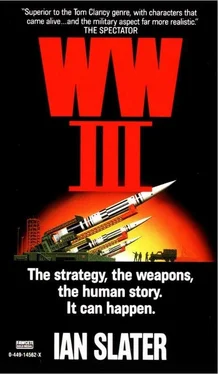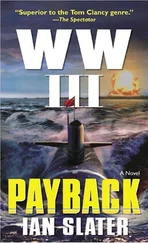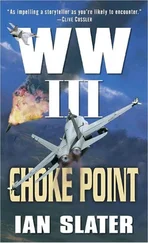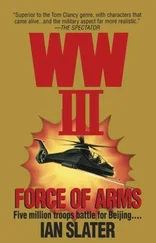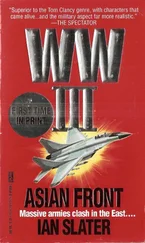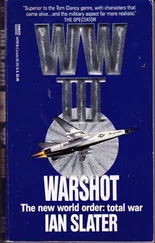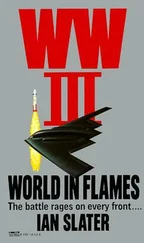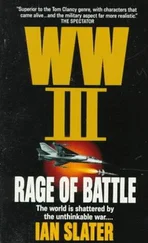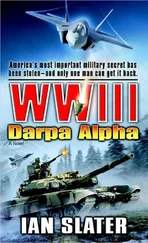Within fifteen seconds Clemens’s M-1 as well as the other five tanks that had also fired into the column and so revealed their positions to the NKA were also under mortar fire from NKA tank support infantry situated in the flooded paddies and from the shoulders of the road. Clemens’s M-1 was retreating down a shallow depression to its next selected firing position on a hillock two hundred yards farther back, still on relatively higher, dry ground above the road. The aim of the return fire from the up-gunned PT-76s’ 105-millimeter cannons, shooting solid APDS — armor-piercing rounds with discarding sabot — was poor, and even when struck, the tank easily deflected two rounds, the M-1’s turret armor so sloped as to deny a “flat-on” impact. Still, the fact that the rounds were coming close told Clemens that the five American M-1s were being sighted through the thick pall of smoke by either laser or thermal imaging, reflecting the NKA’s, that is, the Russians’, military strategy of equipping tanks, even the older models like the PT-76s, with nighttime ranging capability. It was another indication of Soviet military thinking, their belief that their best chance in any battle with the West was a quick win, which meant keeping your crews fighting twenty-four hours a day before the United States had time to rally the political will to reinforce their troops or others in the Western alliance.
The sound inside the M-1 as it geared down, breaking its speed as it approached the tall bamboo, was like some enormous earth mover. But to the few ragtag platoons of supporting U.S.-ROK infantry outside, the M-1 sounded remarkably quiet, not much noisier than a growling pickup as the fifty-four-ton tank moved at over thirty miles per hour across a corrugated stretch of ground, its gun steady and maintaining its six rounds of accurate fire per minute even as it geared up, heading at full speed, over forty miles per hour, toward the heavy stand of bamboo overlooking a curve on the Uijongbu-Seoul road.
“Incoming missile!” shouted the gunner, Clemens dropping down the hatch, which was seated and secure in a second. It was not a round from any of the PT-76s, which were now breaking left and right of the blocked road as the five American tanks opened up from the bamboo and surrounding hills, but a relatively slow, Russian-made antitank “Spiral,” coming in at 560 meters a second, less than half the speed of a tank round. It struck the M-1’s turret, exploding against the two-hundred-millimeter-thick sloped armor, failing to penetrate, the shock wave quickly dissipating throughout the composite, or layered, SPC armor. But it caused a ringing that, even through the crew’s protective earphones, was so intense that along with all the other internal noise of the fifteen-hundred-horsepower gas turbine, controlling gun elevation and depression, the constant hum of the computers and the steady blowing of the air conditioner, the fume sleeve halfway down the barrel evicting noxious gases from the exploded powder, none of the tank’s crew could hear anything on the radio for at least ten seconds. And so they didn’t hear the warning transmitted from the other two tanks in Clemens’s platoon. A second antitank missile, wire-guided, had been fired at them from ten o’clock, from a fringe of smoke fifteen hundred meters away in the paddy off the left-hand side of the road. The Russian-made Sagger, moving at under five hundred meters a second, came through the black and white smokescreen rolling over the paddies, hitting the right track of Clemens’s M-1 as it was nearing the bamboo thicket. There was a muffled explosion, more sound shock, and then a clanking sound, like chains unraveling from a snow tire.
“Damn!” shouted Clemens’s gunner as the tank crashed into the bamboo thicket, the top of which rose a good six feet above the hillock immediately to the right of them, blocking them from the NKA tanks’ view and placing them in a perfect position for defilade fire, providing the driver could manage to turn the fifty-four tons using only the intact left track and what was left of the right.
“Can you do it, Johnny?” shouted Clemens.
“It’ll take the right track off, Lieutenant.”
“Do it!”
The M-1 shuddered right, then the driver, in his forward hull semireclining position, used all the skill he had been taught at Fort Hood, coaxing, talking to the twenty-five-foot-long, eight-foot-high tank, as a cavalry man of old might have cajoled his wounded battle horse, to climb that few feet more up the reverse incline of the bamboo hill to the defilade position. In the lowest gear the tank gave a throaty roar, inching forward on the slippery cane of the bamboo almost to the summit of the hill. Here, given the light rain that was now falling and the smoke, the tank was barely visible, and here its gun, the product of the best engineering in the world, could lay down fire with minimum silhouette. The enemy could return effective fire only if the M-1 could not withdraw before the NKA range finders picked it up. With the right track off, Clemens knew he couldn’t fire and withdraw with any speed and so asked his wingmen, the other two tanks in his platoon, to “overwatch” him, to feed his tank information about any advancing NKA infantry with antitank weapons or PT-76s looking for a lucky shot from the paddies.
On one hand Clemens felt trapped because it would take several hours at least to fix the unraveled track, if they could do it at all in the field. And yet he was in a perfect position with a wide down angle of fire across the paddies now stretching fifteen hundred to five thousand meters in front of him. He was waiting for the smoke to clear. One of the other two tanks he’d requested help from didn’t answer. Whether it was hit hard and out of action or whether its radio had packed it in, Clemens didn’t know. In any case, the other tank gave Clemens the happy information that Cahill had released a full batallion of M-1s, thirty-five tanks in all, which were now rolling up Unification Highway. Within twenty minutes they’d be in the area, engaging the remaining sixty lighter-armed and lighter PT-76 tanks now presumably scuttling across the paddies either side of the road under cover of the smoke, trying to find whatever defensive positions they could. In the interim, Clemens decided to save what was left of his original fifty-five rounds until the smoke curtain cleared.
“How many shots we got left, Luke?”
“Forty-two.”
“What we got on the menu?”
“Ribs, lobster.”
“Never mind the shit — what’ve we got?”
“Shoes, twenty, HE, ten, and twelve HESH.”
It told Clemens he had twenty rounds of solid-shot armor-piercing, ten high-explosive shells, and twelve high-explosives with squash heads.
“Well,” said Clemens, trying not to sound too satisfied up against the PT-76 tin cans. “That should hold us awhile.”
“I reckon,” said his gunner.
* * *
As General Kim in his headquarters six miles east outside Uijongbu was informed of the M-1 spearhead rapidly approaching, his face remained impassive, even as his infantry commanders worriedly reminded him of the cardinal rule: that while it was permissible for tanks to move without infantry, this was only wise when you were advancing and using the infantry as your eyes and ears, but in this situation, with a long line of American M-1 tanks, the NKA armored column would quickly be thrown on the defensive, the supporting regiments behind the NKA tanks slaughtered by the cannon and machine-gun fire of the formidable M-1s unless they were withdrawn. Radio intercepts, Kim’s officers pointed out, already confirmed that the M-1s, their laser range finders thwarted by neither rain nor smoke, were less than twenty minutes away. And, after the executions at Panmunjom, the migooks would surely show no mercy, and would fight eye to eye with the PT-76s. Kim merely nodded. He was already quite aware that he was about to engage in the first massed tank battle since the days of the Israeli-Arab wars.
Читать дальше
